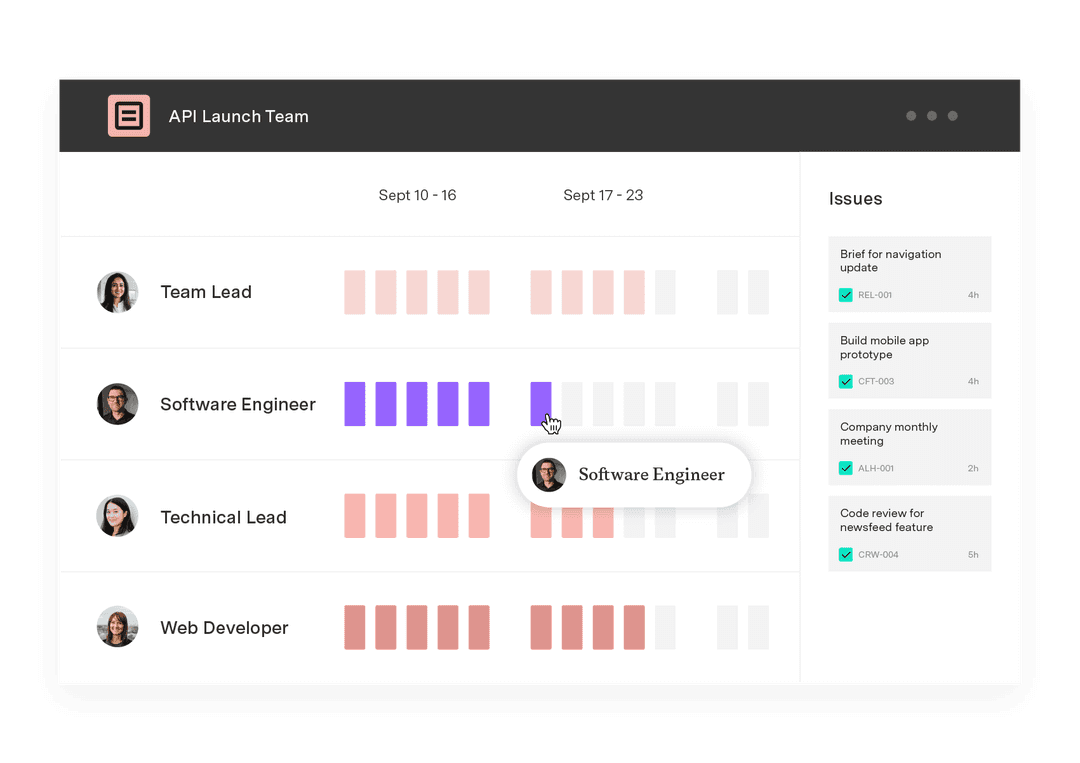A guide to the Hoshin Kanri matrix strategy
Tempo Team
Your organization’s everyday work should always reflect your big-picture strategy. But turning long-term goals into short-term actions isn’t easy. Over time, objectives take a backseat, priorities clash, and accountability fades.
The Hoshin Kanri matrix is designed to prevent those problems. This one-page planning technique helps leaders bridge strategy and execution. It’s a structured approach that links breakthrough objectives with shorter-term goals, initiatives, and performance metrics. The result is a clear view of how each person’s work supports the larger plan.
In this guide, we’ll explain what the Hoshin Kanri matrix is, how to read it, and how to build a custom matrix tailored to your organization.
What’s the Hoshin Kanri matrix?
The Hoshin Kanri matrix is a visual framework that condenses an entire strategy deployment plan onto a single page. In Japanese, “hoshin” (方針) translates to direction and “kanri” (管理) to management. Together, this approach guides your organization toward its long-term vision.
The matrix itself has an “X” shape, so it’s also called an X-matrix. It connects four quadrants:
South: Long-term breakthrough objectives for the next three to five years
West: Annual objectives that make those long-term strategic goals more attainable
North: Key initiatives or projects that move the annual goals forward
East: Metrics and targets that track results
Correlation dots in the corners show how each objective, initiative, and measure relates to the others. There’s also a column for highlighting accountability, showing which leaders are responsible for each element. The end result is a clear picture of strategy deployment – a roadmap between big ambitions and the actions needed to achieve them.
What’s the purpose of a Hoshin Kanri planning template?
The Hoshin Kanri matrix packs a lot of information onto a single page, but you don’t have to create it from scratch. An X-matrix template ensures that you cover all four quadrants and deploy them in a consistent way. It also helps with:
Standardization: Every team outlines its strategic planning in the same format, which reduces confusion and improves vision alignment.
Visibility: Because team members see how long-term objectives connect to annual targets and projects, they’ll better understand their roles.
In short, a template makes the Hoshin Kanri process easier to apply. It gives leaders and contributors a clear starting point for building their own matrices.
How to read a Hoshin Kanri matrix
At first glance, the Hoshin Kanri X-matrix might seem overwhelming. But once you understand the layout, it’s simpler to visualize how a strategic vision breaks down into practical action. Here’s how to read each quadrant.
South quadrant: Breakthrough objectives
The bottom of the Hoshin Kanri matrix contains the long-term strategic goals that set the organization’s direction. These describe where leaders want to take the business over the next three to five years. That could be entering a new market, doubling customer satisfaction scores, or launching a major product line.
West quadrant: Annual objectives
On the left are one-year objectives that push progress toward the breakthroughs. They’re tactical, specific, and measurable. For instance, if the breakthrough goal is doubling customer satisfaction in three years, the annual objective might be raising your Net Promoter Score (NPS) by 10 points.
North quadrant: Top-priority improvement initiatives
At the top of the Hoshin Kanri matrix are the projects and programs that bring annual objectives to life. These strategic initiatives represent the investments and execution steps, like implementing new software or conducting a thorough competitor analysis.
East quadrant: Metrics and targets
On the right are measures that show whether initiatives are working. These might include revenue growth, defect rates, cycle times, and other KPIs. With clear targets in place, the matrix shows whether objectives are on track or need adjustment.
The far right: Resource/owner assignment
Many Hoshin Kanri matrices include space on the right, where you can list owners or responsible leaders for each initiative. This keeps accountability at the forefront, and shows team members who they should contact with questions.
Pros and cons of the Hoshin Kanri methodology
Like any matrix organizational structure, the Hoshin Kanri method has strengths and limitations. Understanding both will help you decide whether it fits your organization’s goals and direction.
So what does this strategy have to offer? Building a Hoshin Kanri matrix provides your team with:
Strategy that’s tangible: Translating broad ambitions into concrete actions and measures makes reaching the finish line more realistic.
Improved clarity and alignment: By connecting long-term vision to short-term execution, the matrix ensures that every small step moves your organization towards its primary objectives.
Better communication: As a visual framework, the matrix encourages dialogue across teams and keeps everyone on the same page.
Built-in accountability: When clear owners are assigned to initiatives, and metrics are tied to specific goals, accountability follows naturally.
While those are some compelling benefits, there are a few potential drawbacks to keep in mind:
Risk of clutter: Putting too many strategic goals on one page can overwhelm your team and dilute focus.
Difficult to update: Once documented, revising the matrix can take time – time that many organizations in fast-changing markets don’t have. Pairing this technique with a risk management plan and careful value stream mapping helps you address uncertainty and keep strategies flexible.
Possible lack of support: The methodology only works when the whole organization is onboard. Without broad commitment, a Hoshin Kanri matrix can easily become just another document in the pile.
The Hoshin Kanri method: 9 key steps
If you’ve weighed the benefits and downsides, and you’ve decided to implement this strategy, it’s time to get to work.
Building and deploying a successful Hoshin Kanri plan requires more than just filling out the matrix. It’s vital to take your time with this process, and involve all key teams and leaders.
Every business will go about building its Hoshin Kanri matrix differently. Still, there are some key steps you’ll want to include:
Establish your overall vision and mission: Before anything else, you’ll need to articulate a clear strategic vision and mission for your organization. This will set the foundation for future objectives and act as a north star for making decisions.
Define your breakthrough objectives: Next, you’ll identify medium-term strategic goals. These should be ambitious but realistic. Perhaps you want to expand into a new market, or you’re aiming to reach industry-leading quality standards. Focus on what can reasonably be accomplished in a 3 to 5-year timeframe.
Set your annual objectives: Once your breakthroughs are in place, you can translate them into specific, measurable annual goals. Each should be achievable within one year, and should be a clear stepping stone towards one or more of the larger objectives.
Clarify your key initiatives: Analyze each annual goal, and identify the projects that will make that goal possible. This shouldn’t be an exhaustive list of every possible initiative. Instead, choose a few top priorities that will have the greatest impact.
Choose relevant metrics: Any useful goal is measurable. Your organization must be able to identify when each annual goal is met, in clear and objective terms. Again, don’t try to focus on every potential metric. Select the ones that are most important to your vision, and most relevant to your specific objectives.
Communicate the vision to your team: Everyone should be aware of the matrix, and educated on how to read it and use it to guide daily work. In addition, make sure you’ve assigned clear ownership over key initiatives, projects, and tasks, and implement a way to ensure alignment over time.
Implement your initiatives: With the plan in place, execution begins. Teams can now implement the initiatives specified in the matrix, and use it to prioritize projects, allocate resources, and track progress.
Conduct monthly reviews: Monthly reviews serve as checkpoints to monitor progress and evaluate metrics – insights you’ll need to adjust course if necessary. Ask for plenty of feedback from everyone involved, especially when this strategy is still new.
Perform an annual review: At the end of each year, it’s time to conduct a more thorough check-in. You can assess outcomes, compare results to objectives, and refine your direction for the coming year.
If you take one thing away from this article, remember that your Hoshin Kanri matrix should be flexible. You can’t foresee what will shift in your organization and industry over the coming years. A strong strategy is carefully considered, but also adaptable to unforeseen changes and complications.
Connecting Hoshin Kanri planning to execution with Tempo
Building a Hoshin Kanri matrix sets your strategy in place, but strategy only matters if it leads to execution. How can you bridge that gap?
At Tempo, we provide organizations and leaders with the tools they need to progress from vision to results. Our Structure PPM platform gives you a portfolio-level view of every key initiative, and can be tied directly to your matrix. You can organize and prioritize work, link objectives to projects, and monitor progress in real time – all within Jira.
For even better results, you can pair Structure PPM with Tempo’s resource management tools, such as Capacity Planner, Timesheets, and Financial Manager. Together, this suite of powerful solutions helps you identify available capacity, keep workloads balanced, and communicate seamlessly.
The result is a pipeline that keeps strategy visible, measurable, and achievable – and ultimately delivers on the goals you set.
Set your team up with Structure PPM, and turn your breakthrough objectives into measurable outcomes.











































